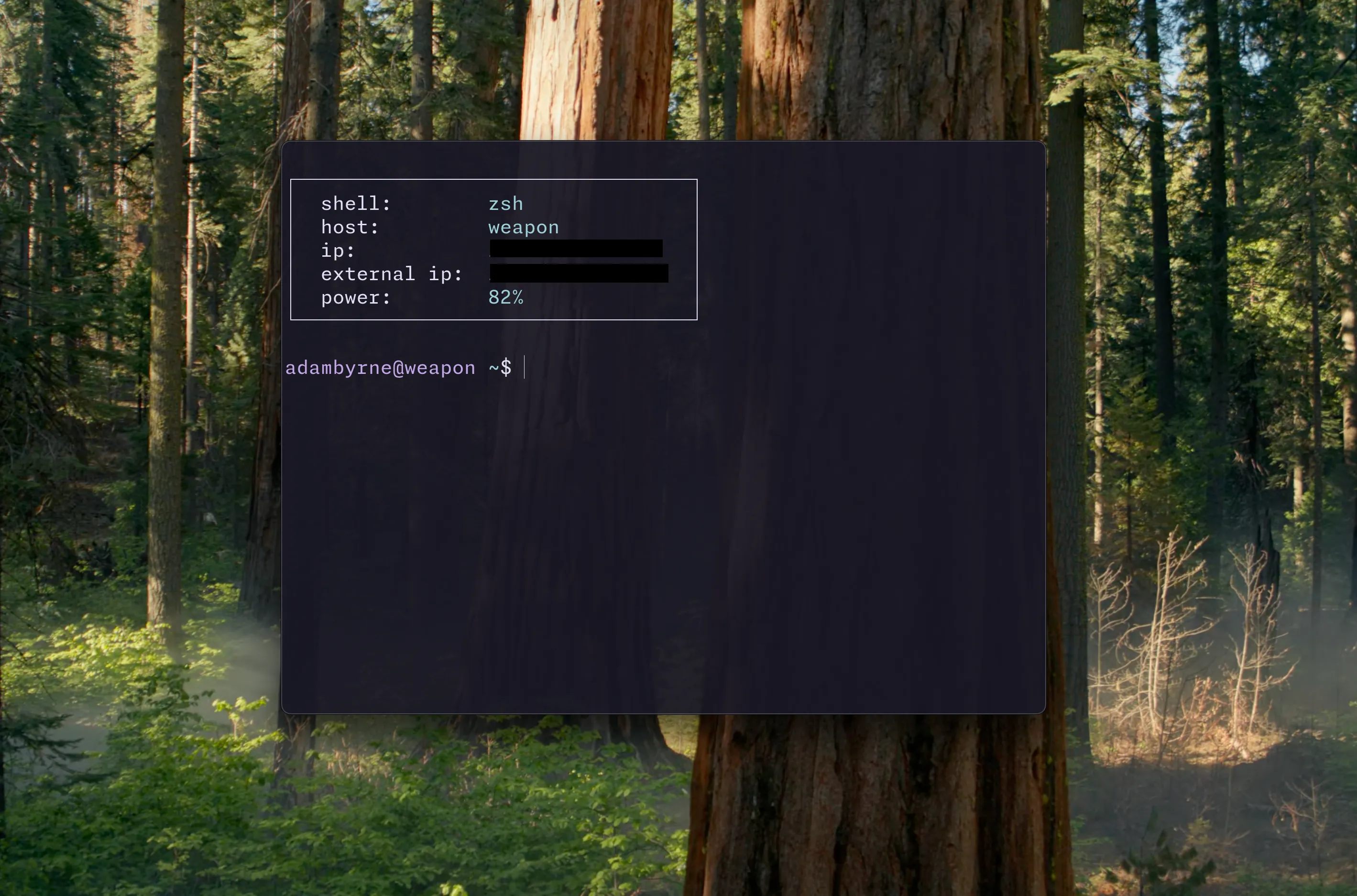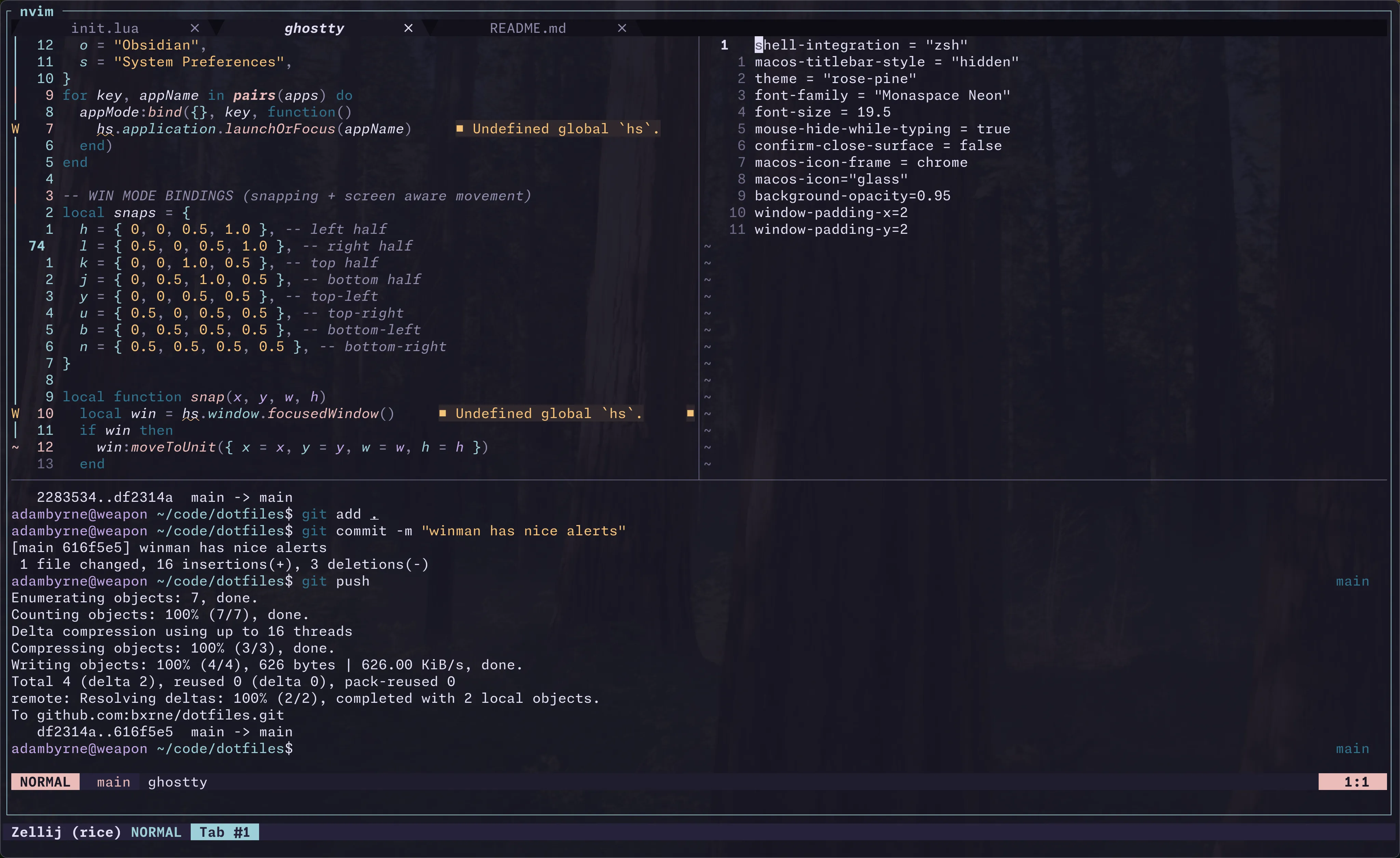This has been overhauled on master (no MacOS)
I had been using these tools for a while, but recently consolidated them into a single dotfiles repo. This lets me clone it onto a new machine and be ready in a minute or two (plugin install wait). My course has 5 residencies/internships and among other placements I have had, I have had many coldstarts so this setup is well tested.
git clone https://github.com/bxrne/dotfiles.git ~/dotfiles
ln -s ~/dotfiles/.zshrc ~/.zshrc
ln -s ~/dotfiles/.config/nvim ~/.config/nvim
ln -s ~/dotfiles/.config/zellij ~/.config/zellij
ln -s ~/dotfiles/.config/ghostty ~/.config/ghostty
ln -s ~/dotfiles/.hammerspoon ~/.hammerspoon Tools
Hammerspoon
I use Hammerspoon to manage my window layout and keyboard shortcuts. It is a powerful tool that allows you to write Lua scripts to control your Mac. I have a few scripts for window management, launching applications, and other automation tasks.
I added modes to my Menu bar NOR, APP amd WIN.
NOR is normal mode, everything behaves unconfigured.
![]()
APP allows me to hit t to open a terminal, c to open chrome etc for the top 5 apps I use.
local apps = {
c = "Google Chrome",
t = "Ghostty",
w = "Windows App",
d = "Docker Desktop",
f = "Finder",
o = "Obsidian",
s = "System Preferences",
}
for key, appName in pairs(apps) do
appMode:bind({}, key, function()
hs.application.launchOrFocus(appName)
end)
endWIN allows me to maximise, centre, and move windows to diagonal and horizontal halves of the screen.
local snaps = {
h = { 0, 0, 0.5, 1.0 }, -- left half
l = { 0.5, 0, 0.5, 1.0 }, -- right half
k = { 0, 0, 1.0, 0.5 }, -- top half
j = { 0, 0.5, 1.0, 0.5 }, -- bottom half
y = { 0, 0, 0.5, 0.5 }, -- top-left
u = { 0.5, 0, 0.5, 0.5 }, -- top-right
b = { 0, 0.5, 0.5, 0.5 }, -- bottom-left
n = { 0.5, 0.5, 0.5, 0.5 }, -- bottom-right
}Ghostty
Have been using the Ghostty terminal for a while, its nice and minimal with a focus on speed, it also handles transparency well.
Z-Shell
I use Z-Shell as my shell for the completions and omz for the plugins and theming (rose-pine).
I have tried fish but I prefer the bash-ness of Z-Shell for scripting and the compatibility with other tools.
Usually you could install nerdfetch, neofetch or nerdfetch for a nice terminal prompt but installing something in place of what is a small script is not worth the second wait for it to run, so i wrote a small one that gives a nice simple prompt:

Editor
Have gone back and forth on this one since day one. Started with Notepad++ then Sublime Text. Spent most time in VSCode but a few years ago I put in the effort to learn the Vim motions in VSCode and then switched to using Neovim as my main editor. Mainly use harpoon here for file navigation with oil and fugitive for git integration.
But AI?
Yea. Cursor is great, so is Windsurf but Github Copilot serves it purpose on the auto-complete side and to be honest my LSP is often good enough.
I have found the AI tools better in the agent format where they can use bash tools (grep, sed, etc) without the bloat of a electron IDE and usually throw them in a different git worktree so they can work in parallel to my work without affecting it (can spin up a few virtual interns for easy JIRAs). My favourite so far is sst/opencode via the Github Copilot backend (free for students 🙌), though interested to see how Charm’s crush evolves.
Terminal Multiplexer
For work (VMs) and for personal I always have a few layouts/sessions to keep open (or running) so after using tmux for a while I switched to Zellij as it worked for me better without config (tmux had too many collisions for me and felt unintuitive in comparison). Easy navigation between sessions, panes, tabs and windows.

If you’re thinking, “wow, could’ve done proper work instead” - yea your right, but there is value in learning how your shell, editor and your machine works and you can write off the EffortEx for the DevEx long term ;).